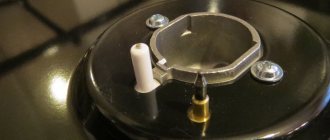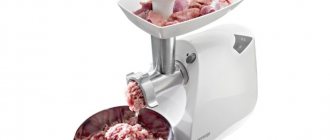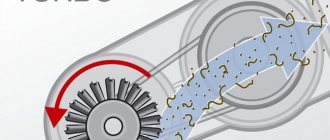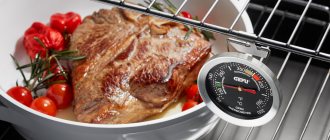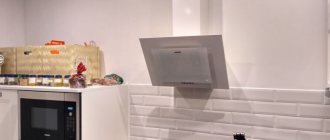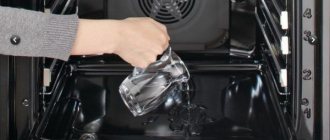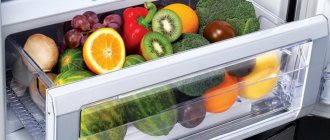What is convection
Convection is the movement of heat by air currents inside the oven. During the process, cold and warm air masses are exchanged and mixed, as a result of which the temperature inside the furnace becomes the same and uniform throughout the entire volume of the enclosed space.
Depending on the mechanism of action, it is customary to distinguish between natural (free) convection, when air flows mix naturally. In this case it happens quite slowly. There is also forced convection, the principle of which is incorporated in modern ovens; this is a mode of forced circulation of warm air in the space, which is carried out thanks to special fans.
Why is convection needed?
It is difficult to overestimate the advantages of the convection mechanism in an electric oven or other device. This technology is provided in most modern household ovens. First of all, it is indispensable when baking large pieces of meat, pies, making pizza, grilled chicken or toast.
Convection promotes uniform cooking of the dish, with its help you can avoid burning in one part of the dish and inadequate baking in another. Previously, to do this, you had to constantly turn the sheet over and change the position of the dish on it. The technology allows you to cook large pieces of fish or whole meat. In addition, convection adds a number of advantages:
- rapid warming up of cold air, accordingly, saving time to obtain the desired temperature;
- the appearance of a crispy crust, the ability to dry out an overly juicy dish;
- possibility of simultaneous preparation of several dishes;
- in the presence of moist convection, food is partially steamed, retaining more beneficial properties and minerals.
How to tell if your oven has convection
If, when purchasing an oven, you did not inquire about the presence of such an important technology in it, then special signs on the control panel will help you understand this issue. On different models and on different convection type options, they may differ, but most often they are presented in the form of a fan icon, as well as indicators of its operating modes.
Principle of operation
The operating principle of convection is based on an active heat exchange process, which is achieved using a powerful fan located on the rear wall of the heating chamber. It accelerates the movement of air flows, thereby facilitating rapid heating of the oven volume.
Do you need convection in an electric oven?
Although modern models are mostly presented with a convection function, it is not difficult to find a model on the market without it. When purchasing, everyone must decide for themselves whether the convection function is needed or not.
There are some users who, even having bought an electric oven with this function, used it only a few times. If the equipment is purchased with a specific desire to please your family and loved ones every day with a variety of dishes and baked goods, then this function is of course desirable. When purchasing, additionally find out all the details of a specific model with convection from the seller, so that later you do not have to be disappointed in the product.
What is convection in the oven for?
It allows you to successfully bake large pieces of meat, bake wonderful pies, make delicate meringues and even simply dry herbs, delicious candied fruits or crackers. You can even skip the heat by using just cold convection. And in combination with low heat, convection will allow you to quickly defrost meat or vegetables from the freezer.
The convection mode will allow you to use the entire volume of the oven with maximum efficiency: even if you put two or three baking sheets inside, everything will bake evenly.
- It is not necessary to use this function every time you cook. It can be turned on in cases where it is really necessary:
- to ensure a crispy crust;
- to dry out too much liquid released from baked products;
- for good baking of a large pie or poultry carcass.
The modern convection oven has various baking, grilling and defrosting modes. This allows you to cook several dishes at the same time, which significantly reduces gas (electricity) consumption and the amount of cooking time.
Detailed instructions from the manufacturer tell you how to configure the necessary parameters. So, convection is a function in which forced air circulation occurs inside the oven, due to which the same heating temperature is formed on all sides.
- To understand whether convection is needed in the oven, let’s look at the advantages of this function:
- Uniform temperature. Dishes are baked on all sides at once.
- Cooking several dishes at the same time.
- Replaces hobs. In some cases, such an oven allows you not to use standard hobs (in the country, in country houses, etc.).
- Minimizing electricity and gas consumption.
- Additional modes - for baking, defrosting, drying.
- Full control and security. You can always turn off the blowing function yourself.
Advantages
Many people ask why the convection mode is needed if meat is baked perfectly in the oven without it? Why turn it on and what dishes to cook with it? This question was partially answered in the previous section.
- A convection oven has a number of advantages:
- the dish is baked evenly;
- you can cook food on several baking sheets at once;
- you can do without a hob;
- less electricity or gas consumption;
- less oil consumption;
- The range of dishes that you can cook in the oven is expanding.
In the oven, meat and fish are defrosted with a stream of hot air, medicinal and spicy herbs are dried, nuts and lemon zest are dried. The oven makes excellent meringues and various pastries made from dough. If convection is not needed, then the mode is simply not turned on.
Indeed, how many times have housewives been faced with a situation where it is necessary to cook both a side dish and meat at the same time? And when you have to bake a cake from several layers? In the latter case, cooking was delayed for several hours: first the first cake was placed, when it was baked - the second, then the third, and so on.
It was only a dream to cook several cakes at the same time on different levels. In a convection oven, you can spread the dough on several baking sheets, and it will bake equally well on all of them.
Why else should you choose a device with convection? Not everyone knows that convection can be used to dry berries and herbs. How did you usually dry it in ovens before? We laid out the food on a baking sheet, turned on the minimum heat, and opened the door.
To prevent the berries from burning, you had to stir them regularly and monitor the temperature. If you use convection in the oven, everything becomes much simpler. The fan blows the greens and berries evenly, as a result they dry quickly and do not burn.
In this case, the upper and lower heaters do not need to be turned on at all - the convector is often adjacent to an additional low-power circular heating element, which is turned on together with the fan.
In ovens, convection is often combined with other heating methods. The more expensive the model, the more functions it has, the more combinations for preparing a variety of dishes it can have.
Free and forced convection
The movement of warm air masses itself, as noted above, is convection. But depending on what prompts them to circulate and mix, it is customary to distinguish between free (natural) and forced convection. Free convection occurs on its own in many processes, and occurs without external influence. Hot air becomes lighter, causing it to rise upward. Cold, being heavier – down. The efficiency and speed of such natural convection is much lower than that of forced or forced convection.
In the case of forced convection, air masses, under the influence of, for example, a special fan, circulate and mix much faster and more efficiently. As a result, hot air flows are fairly quickly distributed evenly in a confined space.
Types of convectors
Since the appearance of the first ovens with convection function, various types and modifications of this technology have appeared. And today there are many types of them:
- A fan is the simplest type of convection. The bottom line is that when the fan blades operate, the air inside begins to actively move and mix, resulting in uniform baking of dishes.
- Fan with ring heater. This is already a more efficient system. In this case, the fan has an additional heating element, as a result of which warm air flows fill the space much faster.
- Reinforced convector. The meaning lies in the name itself. Essentially, this is the same fan, but much more powerful. With such a system, the air warms up much faster and more intensely. The food in the oven quickly becomes covered with a thin, pleasant crust on top.
- Moist convection. In this case, a steam generator is also built into the oven, due to which the air inside is actively saturated with steam. This is stewing, not frying. At the same time, the dishes turn out juicy, they retain more nutrients.
- Double convection. With this type of convection, which is also installed on some oven models, two fans are located opposite each other, each of which forces air masses to circulate at its own level. This type is most convenient when preparing several dishes at the same time.
Each of these convectors has its own advantages. For example, reinforced ones are best suited for roasting meat. Before purchasing a specific model, you should ask the seller what kind of convection system is installed in the selected model.
Details
Types and device
Types of convection
The question of the need for convection mode in the oven interests many people. They often ask it to consultants at home appliance stores. To understand all the benefits of this option, you need to know what types there are.
- Natural - as mentioned above, with this type the air flows themselves move around the chamber.
- Forced - inside the chamber, on its back wall, there is a fan that moves air flows forcibly.
- Steam or wet - with this type, the steam level can be controlled independently. In this case, the food retains more nutrients.
Convection oven device
To better understand why convection is needed, you must first understand the structure of this device. It consists of two burners at the bottom, which, after turning on, begin to gradually heat the air and raise it to the top. Some oven models have top heating elements that help get a beautiful crust on your food. Convection forcibly exchanges heat inside the oven, due to which the entire volume of the chamber is heated.
REFERENCE! If there is a baking sheet in the oven that is equal in width to the size of the chamber, the food will burn in it. This is explained by the fact that natural heat exchange is disrupted on the sides.
What is convection in an oven?
To properly use additional oven modes, you need to know how they are indicated on it. The convection icon is similar between different manufacturers. Let's look at the main symbols most often found on ovens.
- Double horizontal line - convection.
- The horizontal line above which the fan is drawn means that only the bottom heating is working.
- Three triangles on top - the presence of a grill.
- Three triangles and a fan - turbo grill with convection.
- A circle with a fan drawn inside it - food is cooked using air currents accelerated by the fan.
- A fan with horizontal lines on both sides - the work of convection and heating elements at the top and bottom.
- There is a fan in a circle, a horizontal line at the bottom - the presence of a defrost, heating mode, in which convection and bottom heating work.
Convection in different ovens
Electric oven
To understand how convection works in an electric oven, you need to understand the principle of air movement in the chamber. A fan is installed in it, with the help of which air flows are mixed. When the set mode is reached, convection automatically turns off. It turns on again when the air layers begin to mix unevenly again.
Gas oven
In gas stoves with a convection function, the burner is located at the bottom, so it is quite difficult to achieve a uniform distribution of flows. First, you need to turn on the cabinet and wait a little so that the heat is distributed evenly throughout the chamber.
REFERENCE! You can put the dish in the oven only after this.
Built-in ovens with a conventional function operating on gas have several disadvantages:
- The cooking time increases.
- There is no sealing in the oven because combustion products need an outlet.
Why do you need convection in an electric oven?
Many people do not know whether convection is needed in an electric oven. Definitely needed. In such a device, heating elements are installed along a circuit, which greatly reduces cooking time. You need to understand that the convection function in the oven is not needed for all dishes, so you can save electricity by doing this. This also has some disadvantages - dry air can make dishes dry, taking away their juiciness.
Convection oven with grill
With the help of a grill, dishes acquire an appetizing and golden brown crust, but for this you need to choose the right function. It is best suited for meat, fish and baked goods.
Using the grill, baked goods are baked on all sides, acquiring a good volume. If the space in your kitchen does not allow you to install a standard-sized oven, then you can purchase a countertop oven with convection.
Convection in the microwave
Such microwave ovens can not only heat up, but also completely cook a variety of dishes. During the cooking process, the food is baked evenly and acquires a beautiful crust.
Among the advantages of such a device are the following:
- You can select several modes at once.
- You can save time.
- Cooked meals are healthier.
This type of microwave also has disadvantages:
- Small size, which results in reduced capabilities.
- Cooking in a microcooker can only be done on certain plates.
- Consumption of large amounts of electricity.
- High price.
REFERENCE! Instead of a microwave oven, it is better to purchase a tabletop electric oven with a convection function.
Devices with convection function
Gas convection oven
Gas stoves with built-in convection ovens are popular with many practical housewives. This is primarily due to the relatively low cost of fuel. Externally, such a stove is practically indistinguishable from an ordinary modern gas stove. However, a special fan is built into the back wall of such devices.
The convector in such a stove has a number of operating features. Since in these models the heating part is located at the bottom, before putting the dish in the oven for cooking, you must first turn on the convector for a short period, and then send the dish into the oven for cooking.
The disadvantages of this type include the lack of complete sealing of the oven, since it is necessary that combustion products have a constant outlet. This ultimately leads to longer cooking times.
Electric convection oven
Some housewives wonder how necessary convection is in the oven, because it itself is a fairly powerful fryer, capable of heating up to a temperature of several hundred degrees. In fact, even such a powerful flow of warm air is not capable of ensuring ideal uniformity of its distribution, and, accordingly, uniform cooking of the dish.
Today, voluntarily abandoning the convector in the oven is not a reasonable decision. It is thanks to him that it is possible to achieve ideal uniform baking of the dish, juiciness and crispy crust on the surface. It’s no wonder that models of electric stoves with convection are the most popular among buyers today.
Grill with convection
The grill function quite often comes as part of the options of modern stoves. The grill allows you to easily and efficiently cook meat on a spit. There are two types of grill:
- Gas. In this case, there is a high-quality imitation of cooking over coals.
- Electric. Its feature is more convenient operation.
Grill and convection combine perfectly and complement each other. There are two types of grills: air grill and turbo grill. The desired mode is very simply activated by pressing the corresponding button on the control panel. The advantage of using an air fryer is the ability to obtain high-quality roasted meat with a crust.
What is convection in a microwave oven
For a long time now, the microwave oven has become an integral part of the kitchen equipment set of most families. It allows you to quickly heat up various foods and semi-finished products, and defrost foods. Microwave ovens today also use convection quite often.
Moreover, in essence it does not differ from that in a standard oven, except for the size. The fan distributes air flow inside the chamber. When a certain temperature is reached, the system automatically turns off. The use of convection in microwave ovens can significantly reduce the time of defrosting and cooking food.
What is convection like?
There are two main types of convection - natural (available in absolutely all ovens) and forced (improved, activated by a button).
- Natural convection in gas and primitive electric ovens is determined by the laws of physics: warm air rises and cold air moves down. This heat exchange is quite slow, and it is very easy to interfere with it. For example, if the oven door does not close tightly, it is often opened or wide baking sheets are used, a large number of dishes are baked at once, the circulation of hot streams is disrupted. The result is burnt, unbaked dishes, fallen biscuits, and a hard, unappetizing crust.
- Natural convection in modern electric stoves. Here the situation is a little better. As a rule, new stoves use several heating elements located around the perimeter of the cabinet. When using bottom and top heating, hot air moves more actively. Dishes are not so afraid of opening the door or other negative factors. However, natural convection cannot be compared with a special function.
Forced convection
Forced convection is called convection, which is caused by the action of external forces. In an oven, the fan becomes that force. It comes in several types:
- Ordinary. Moves air through simple blowing.
- Fan with heating circuit. It not only blows air, but also heats the oven, which increases its efficiency.
- Reinforced fan. Creates a more powerful flow of hot air, which makes food bake faster and better.
- Double fan. To enhance convection, two fans are sometimes built into the oven. They are located one above the other and blow air at each level. This is very convenient when baking several dishes at once.
- Moist convection. Relatively new technology. In addition to the fan, the oven has a steam generator that evaporates water from a special compartment. The fan circulates moist air throughout the chamber, so the food remains juicy and does not dry out. Dishes are steamed or stewed rather than baked. Moist convection allows you to preserve maximum benefits in products. In some oven models, the humidity level can be adjusted.
- Convection with grill. The function activates the fan and grill simultaneously. This combination allows the heat to be concentrated around the food being cooked. The dish turns out juicy, with an appetizing crust. Recommended for cooking large pieces of meat, whole vegetables, and fish.
We recommend: How often should you change the carbon filter in your kitchen hood?
Convection in gas and electric stoves
Today, almost every modern electric stove is equipped with a convection mode. The models differ only in the type of fan. It can be regular or with “bells and whistles” - reinforced, double, with a steam generator, etc.
The situation is different with gas stoves. The blowing function is only available in expensive models. This is due to the need to install additional protection. After all, if the fan blows out the flame, a gas leak will occur. Therefore, manufacturers, along with a fan, equip gas stoves with a gas control system and a protective shutdown. When the fire goes out, the gas supply is blocked.
Convection mode indicators
The main differences between wet convection, enhanced and dry
- Wet circulation. With this technology, in addition to the usual heating of the air, it is also actively saturated with moisture. This makes this convection ideal for steaming dishes.
- Increased circulation. The main detail in this case is a reinforced powerful fan. Perfect for those cases when you need to achieve a crispy crust on the surface of the dish.
- Forced dry circulation. In this case, the oven contains several fans, which also often have additional heaters.
The most useful programs
- Normal convection. Used for heating dishes, preparing dough before baking, drying herbs, berries and fruits.
- Convector, bottom heater and grill. This is the optimal mode for cooking semi-finished products.
- Convector and bottom heater. This mode is ideal for baking pizza, pies, and bread.
- Turbo grill. When this mode is turned on, the top heater, convector and grill are activated immediately. Good for cooking large pieces of meat.
All of these modes, except regular convection, should be used for a baking tray set at the same level.
Double convection
There are also models on the market with two convectors installed simultaneously. The main brand that produces such ovens is Samsung. The presence of two fans allows you to distribute and warm up the air masses much more efficiently.
Before purchasing equipment with this function, you should make sure that such a choice will be justified. The presence of this function significantly increases the cost of the equipment. The choice is appropriate if you plan to regularly prepare dishes in this mode.
Application of humid convection
Ovens in wet convection mode are used for steaming various meat, vegetables and other dishes. The design of ovens with a similar mode consists of the following elements: a fan, a special container for water and a generator that converts water into steam.
How the convection mode is used in practice
In practice, the convector allows you to achieve amazing results. Thick pieces of meat and fish are baked with high quality and get an even crispy crust on all sides. The dish turns out moderately juicy. The mode significantly simplifies the process of preparing complex dishes, while saving energy consumption (gas or electricity).
Important! When the function is activated, the air temperature in the oven is 10-15° higher than with standard heating, which speeds up the cooking process by 20-30%. When setting the timer, the user must take this feature into account.
Application examples.
- Activating the function without heating or with slight heating allows you to quickly defrost food. In this mode, berries, fruits cut into pieces, herbs and zest are dried. You can also place the dough on a baking sheet before baking.
- In convection mode with a bottom heater, pies, pizza and other baked goods are baked.
- The function in combination with the top heater is suitable for preparing casseroles, meat dishes and vegetable and fruit soufflés.
- Multifunctional heating mode with forced circulation is suitable for simultaneous baking of pies on several levels at a temperature of 170-190° or confectionery products (from 180°). You can bake large pieces of meat or fish on several levels (from 200°).
- The turbo grill mode is used for roasting whole poultry, pig, and leg of lamb.
- A steam convector is used when preparing steamed vegetable, meat and fish dishes, and baking buns from butter dough. Can be used to sterilize dishes.
So we figured out what convection is. When using this function in an electric oven, it becomes possible to expand the list of prepared dishes and improve the quality of baking. Nothing will burn and everything will bake evenly!
How to use convection
All oven manufacturers describe in detail the process of using this function in a specific model. But as a rule, the algorithm is similar.
When to turn on convection in the oven
When using equipment with this function, no preheating is required, with the exception of models that run on gas or when heating frozen foods.
How to turn it on
Please note that when using a convector, food is cooked at lower temperatures than usual. When switching on, you need to make adjustments of approximately 25 °C.
How to turn off convection
If the mode is not needed, you can simply disable it. To do this, you need to turn the knob to a special indicator. It is different for each specific model and is described in detail in the instructions for use.
How to make convection in an old oven with your own hands
Unfortunately, attempts to independently make a new oven with a convector out of an old oven will often not be successful, so the easiest way is to pay a little extra to buy such equipment in a professional store, which will also come with detailed instructions for use.
Today, convection in household ovens is becoming a common element.
This is understandable - after all, thanks to this function, it has become possible to create truly exquisite culinary masterpieces and delight your loved ones with them. Did you like the article? Was she helpful?
